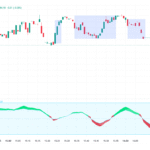
Average True Range (ATR)
In the high-speed game of futures trading, scalping is the favored method for those who want to profit from those minute price fluctuations. One of the greatest resources for scalpers is the Average True Range (ATR), but for some unknown reason, it gets a negative reputation. By 2025, when markets are even crazier, having knowledge of how to apply the average true range will keep scalpers from wasting a huge amount of time. In this article, you’ll learn how to apply the ATR for futures scalping like a pro, why it works, and how to set it up on platforms such as TradingView or MetaTrader.
What is the Average True Range (ATR)?
The Average True Range (ATR) is a volatility indicator developed by J. Welles Wilder Jr. in his classic 1978 book, New Concepts in Technical Trading Systems. Unlike many technical indicators that predict price direction, the ATR measures market volatility. It calculates the average range between the high and low prices over a specific period, usually 14 periods by default.
ATR measures how much of a move an asset makes within a given time horizon. If the ATR is bigger, things are crazier; if it is smaller, it’s chill. Which is why ATR is really helpful with determining targets, stop-loss levels, and maximizing your entry and exit points when scalping futures.
Why Use ATR for Scalping Futures?
Futures markets — be it E-mini S&P 500, crude, gold, or micro contract futures — are extremely popular for their speed of price change. Scalpers need to jump into positions quickly, typically just looking to capture a couple of points or ticks per trade. Honestly, though, most scalpers lose money because they are not watching market volatility.
It’s where the Average True Range strategy truly excels:
- Determining the market’s vibe: ATR informs whether there is sufficient volatility for some fast scalping opportunities.
- Increases trade size and stops: Scalpers are able to determine reasonable stop-loss as well as take-profit levels using ATR rather than relying solely on guesswork.
- Reduces noise: ATR saves you from those low-volatility periods when scalping is not really justified or might be a little dangerous. When using ATR with your scalping strategy, you aren’t blindly chasing movements—you are determining the risks according to what the market is actually doing.
How to Set Up ATR for Scalping Futures
It is extremely easy to set up the ATR on your brokerage platform. All major platforms, including TradingView, MetaTrader 4/5, NinjaTrader, and Thinkorswim, have the ATR as a standard indicator offered.
Here’s a quick setup guide:
- Open your futures chart (e.g., ES, NQ, GC).
- Select the ATR indicator from the indicators menu.
- Set the period to 14 (default), or adjust it depending on your trading style (lower periods like 7 can react faster).
Just put the ATR directly under your main chart. For scalpers, it is common to keep the ATR period short, such as 7 or 10, to identify those sudden changes of volatility.
ATR Scalping Strategy Step-by-Step
Okay, let’s dive into how to scalp futures with the ATR like a boss: Select the Appropriate Futures Contract. First, pick a futures market that suits your style. Good choices for ATR scalping include:
- E-mini S&P 500
- Nasdaq-100
- Gold (GC)
- West Texas Intermediate
- Micro futures (MES, MNQ)
Review contracts with decent liquidity and a stable up-and-down pattern.
Assess Volatility with ATR
Before entering a trade, check the current ATR reading:
- High ATR = High volatility, better for quick scalp trades.
- Low ATR = Low volatility, not ideal for scalping (better to wait).
if it’s an ATR of 5 for a 5-min ES chart, that just means that the typical 5-min candle is fluctuating around 5 points—ideal for scalping.
Set Logical Stop-Loss and Take-Profit Based on ATR
Utilize the ATR value to establish some adjustable stop-loss and take-profit levels:
- Stop-Loss: half or the entire ATR value.
- Take-Profit: Target 1 to 1.5 of the ATR
Example:
- ATR reading is 4 points.
Stop-Loss is approximately 2 to 4 points.
- Take-Profit = 4 to 6 points
This method ensures you’re adapting to real-time market conditions instead of using static, unrealistic levels.
Combine ATR with Price Action or Trend Indicators
While ATR tells you about volatility, it doesn’t provide trade direction. Therefore, you should combine ATR with:
- Simple Moving Averages (SMA) for trend direction.
- Support and Resistance Zones for time entries.
- Candle patterns such as engulfing bars or pin bars.
Confirm trend direction first, then check if ATR suggests there’s enough volatility to warrant a scalp.
Monitor Trade Duration
In futures scalping with ATR, trades usually last 1 to 15 minutes. Set clear exit rules based on ATR moves. Don’t stay too long in a trade—scalping is about grabbing small moves consistently, not holding for hours.
Pro Tips for Average True Range Trading
- Utilize Alerts: Create ATR alerts on TradingView whenever it becomes extremely volatile.
- Adjust to Market Sessions: Volatility (and ATR) tends to rise during major market opens (New York, London). Focus your scalping during these times.
- Don’t Chase: If ATR readings drop considerably, it’s generally wiser to stand back rather than attempting to force trades.
- Use Smaller Lot Sizes: Volatile conditions can lead to sudden price swings. Risk management is critical.
Common Mistakes When Using ATR for Scalping Futures
Even though average true range trading is powerful, many scalpers make avoidable mistakes:
- Ignoring Trend Direction: ATR only measures volatility, not trend. Never rely on it alone to enter trades.
- Overleveraging: Just because ATR shows high volatility doesn’t mean you should risk more than you can afford.
- Using the Wrong Timeframe: Scalping works best on short timeframes (like 1-minute, 3-minute, or 5-minute charts). Using ATR on a 1-hour chart for scalping leads to mismatches.
If your game utilizes ATR directly, you will bypass these common errors.
Why ATR + Scalping is a Hot Combo in 2025
Scalp futures contracts such as the E-mini S&P 500 truly boomed around 2025, and there are a number of reasons why:
- Reduced commissions: Brokers are now handling micro futures with extremely reduced commissions.
- More volatile markets: Economic uncertainty has increased daily ranges.
Yes, great platforms such as MetaTrader and TradingView make using ATR-based scalping techniques extremely simple.
When you combine those trends with a reliable tool such as ATR, you are ready to take advantage of fast, repeatable opportunities all day long.
Explore our newest tools designed to enhance your Forex trading experience effortlessly Check HERE
Conclusion: Master ATR for Scalping Futures
If you need to be a successful 2025 futures scalper, you need to have the Average True Range strategy down pat. ATR informs you of when the market is favorable for you, how much risk, and when to enter and exit trades.
If you focus more on volatility rather than forecasting things, using ATR effectively can seriously level up your trading. Regardless of whether you are scalping the E-mini S&P 500, micro futures, or gold futures, ATR will have your entry and exit positions infinitely more spot-on than ever before.
So why not get started today? Simply slap the ATR on your scalping charts, adjust your take-profit and stop-loss levels according to the live volatility, and watch how your scalping game completely transforms.
When scalping futures, quickness and precision are absolutely crucial. Having ATR with you means that you will hit both.



Pingback: How to Open a Brokerage Account for Futures and Forex Trading - Trading Views